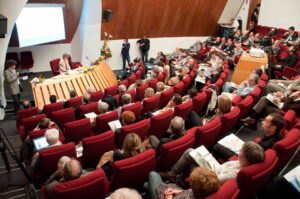PhD defense :
Origins and Rate of Spontaneous Mutations in the Bacteriophage Lambda
A single study estimated the mutation rate of lambda, and concluded that it is 400-fold higher than that of its host, Escherichia coli (7.8 x10-8 per base replicated for lambda vs. 2.0 x10-10 for E. coli). However, the lack of raw data and protocol reduces the reliability of this estimate. The mutation rate is determined by DNA replication fidelity and the error correction efficiency, mainly by mismatch repair (MMR). Because E. coli DNA polymerase III is assumed to replicate both genomes, the high mutation rate of lambda was thought to be due to MMR inefficiency (2-fold increase for lambda vs. 150- fold increase for E. coli, following MMR-inactivation), resulting from incomplete adenine methylation of GATC sites in lambda’s DNA by Dam, crucial for error recognition by MMR. My PhD work aimed to estimate the mutation rate of lambda using different approaches and investigate the mechanisms behind the high mutagenesis of lambda. To achieve this, I re-evaluated the lambda mutation rate and investigated the mechanisms of mutagenesis in lambda, notably the effects of Dam methylation, MMR inefficiency, and polymerases involved in translesion synthesis on lambda mutagenesis. First, I estimated the lambda mutation rate with a high-fidelity whole genome sequencing (Duplex Sequencing or DS), yielding a maximal mutation rate of 1.2 x10-8 per base replicated and validating the MMR inefficiency on lambda DNA. Then, I determined the lambda mutation rate by mutation accumulation plus whole genome sequencing (MAWGS), yielding a rate of 9.2 x10-9 per base replicated. A limitation of these estimates stems from the use of an unverified hypothesis about the exponential replication of lambda. To partially overcome this limitation, I performed fluctuation assays (FA) to determine the mutation rate in cII in a single infectious cycle. After correction of mutations in a polyG (mutagenesis hotspot), I observed that the mutation rate obtained by FA is consistent with those obtained by DS and MA-WGS in wild-type cells (4.7 x10-9 per base replicated). Furthermore, I determined the mutation rate of lambda in MMR-deficient cells, by FA and DS, and found that MMR inactivation increases the mutation rate by 2- to 7-fold, depending on the approach (2.5 x10-8 by DS and 1.8 x10-7 by FA). We also observed that dam deletion increased lambda mutation rate to an intermediate level compared to MMR inactivation, as it was observed for E. coli. Additionally, Dam overexpression did not decrease the mutation rate of lambda, suggesting that the low methylation level does not impact its mutagenesis. Finally, I determined the mutation spectrum of lambda by sequencing 874 cII mutants. The mutation spectrum of lambda is unique in that it differs from that of wild-type or MMR-deficient E. coli and is not indicative of any known mutagenesis pathway in E. coli, preventing conclusions about the mutagenesis mechanisms in lambda. Altogether, these results indicate that lambda mutation rate is about 5 x 10-9 per base replicated, up to 16-fold lower than the previous estimate. This rate, only 21-fold higher than that of the host, would not be explained by MMR-deficiency during the lytic cycle, as previously supposed, but probably by molecular mechanisms that modify the rate and the nature of Pol III replication errors on phage DNA. These mechanisms do not involve the use of error-prone polymerases. My work provides new insights into double-stranded DNA phages’ mutagenesis, and thus, into the control of their evolutionary abilities, which could be useful for using phages against bacterial infections.
Jury members:
- Luisa DE SORDI, Sorbonne Université, Centre de Recherche Saint-Antoine
- Gilles FISCHER, Sorbonne Université, Laboratory of Computational and Quantitative Biology, UMR7238 CNRS
- Ivan MATIC, Université Paris-Cité, Institut Cochin, INSERM
- Clara TORRES-BARCELO, Université de Montpellier, PHIM Plant Health Institute, INRAe, CIRAD, Institut Agro, IRD
Directed by:
Marina ELEZ (Research Director, Micalis Institute, INRAE, MuSE team) and Marianne DE PAEPE (Research Director, Micalis Institute, INRAE, MuSE team).




